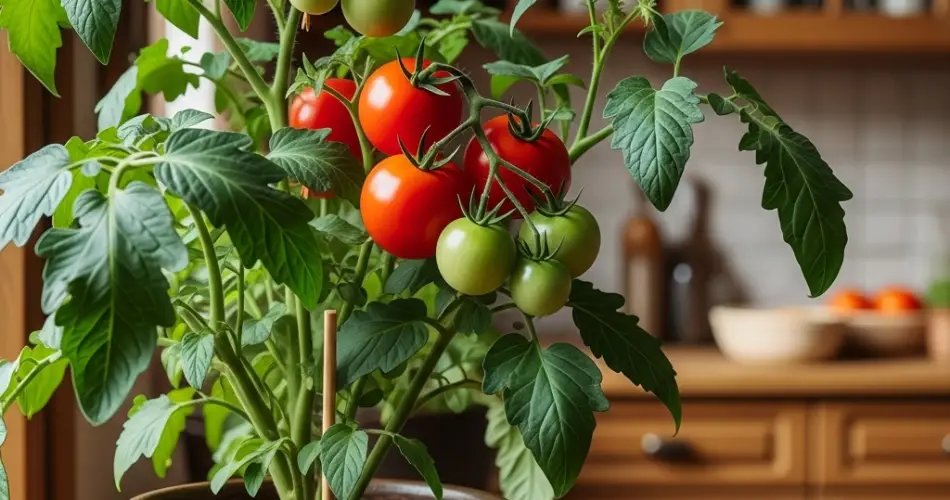Growing tomatoes in containers is one of the easiest and most rewarding ways to enjoy fresh, homegrown produce—no matter how small your space is. Whether you’re working with a balcony, patio, or windowsill, a few pots are all you need to start producing delicious tomatoes from the comfort of your home.
Tomatoes adapt well to containers and, with a little care, can deliver impressive harvests. With proper planning, even a single pot can yield enough for salads, sandwiches, sauces, or just fresh snacking.
Why Grow Tomatoes in Pots?
Tomatoes are naturally sun-loving and vigorous growers. When placed in pots, they offer several advantages:
-
Space efficiency: Ideal for apartment dwellers or those without access to garden beds.
-
Mobility: Containers can be moved to chase the sun or protect from heavy rain or wind.
-
Soil control: Using high-quality potting mix eliminates problems from poor or contaminated soil.
-
Pest management: Potted plants are easier to monitor and isolate from garden pests or diseases.
With the right setup, growing tomatoes in containers can be just as productive as growing them in the ground.
Choosing the Right Container
The key to success starts with selecting the correct pot. Tomatoes need space to stretch their roots and remain stable as they grow.
-
Size: Use at least a 5-gallon container per plant. Larger is better for fruiting varieties.
-
Material: Plastic, ceramic, clay, grow bags, or even repurposed buckets all work, as long as there are drainage holes.
-
Drainage: Essential to prevent root rot. Always drill holes if your chosen container doesn’t already have them.
Consider placing a saucer under each pot to collect excess water and protect flooring.
Soil and Fertilizer
Tomatoes are heavy feeders and thrive in nutrient-rich, well-draining soil. Avoid using garden soil directly, as it’s too heavy for pots and may harbor pests.
Recommended mix:
-
2 parts quality potting soil
-
1 part compost
-
1 part perlite or coco coir for improved drainage and aeration
Mix in a balanced slow-release fertilizer at planting time. Once the plants are established, use a liquid tomato fertilizer every 10–14 days, especially once flowering and fruiting begin.
Best Tomato Varieties for Containers
While almost any tomato can be grown in a container, some types are especially suited to small spaces:
-
Determinate (bush) varieties: These grow to a fixed size and produce fruit all at once. Examples include ‘Patio Princess,’ ‘Roma,’ and ‘Bush Early Girl.’
-
Cherry and grape tomatoes: Compact, prolific, and great for containers. Try ‘Tiny Tim,’ ‘Balcony,’ or ‘Sweet Million.’
-
Dwarf varieties: Specifically bred for containers, they require minimal support.
Indeterminate (vining) types can also grow in containers, but they’ll need large pots, regular pruning, and strong support.
Planting Steps
-
Fill the container with your prepared potting mix, leaving about 2 inches from the top.
-
Plant your seedling deep—up to the first set of leaves. Tomatoes develop roots along buried stems, which helps create a strong base.
-
Water thoroughly after planting.
-
Insert a stake, trellis, or tomato cage at the time of planting to avoid disturbing roots later.
Position the pots where they’ll get at least 6–8 hours of direct sunlight per day.
Ongoing Care
-
Watering: Tomatoes in containers dry out faster than in-ground plants. Water when the top inch of soil feels dry—sometimes daily in hot weather.
-
Mulching: Add a layer of straw or shredded leaves on top of the soil to help retain moisture.
-
Pruning: For indeterminate varieties, remove suckers (the shoots between the main stem and leaf branches) to encourage airflow and better fruiting.
-
Support: As your tomato grows, continue tying it to the support structure to keep it upright and productive.
Watch for signs of nutrient deficiency (yellowing leaves, small fruit) and adjust fertilization as needed.
Pollination and Flowering
Tomatoes are self-pollinating, but in still environments, like indoor balconies, gently shaking the plant or using a small brush to move pollen between flowers can help ensure fruit sets properly.
Once flowering begins, consistent watering and feeding are essential for healthy fruit development.
Harvesting
Tomatoes are ready to pick when they’ve reached full color and feel slightly soft to the touch. For cherry varieties, this can be just a few weeks after flowering. Larger varieties may take a little longer.
Harvesting regularly encourages more blooms and more fruit. Pick with a gentle twist or use scissors to snip them off the vine.
Common Issues and Solutions
-
Blossom end rot: Caused by calcium deficiency and irregular watering. Prevent it by maintaining consistent moisture and adding calcium-rich fertilizer.
-
Cracked fruit: Typically due to irregular watering. Water evenly and avoid long dry spells followed by heavy watering.
-
Aphids or whiteflies: Wash them off with water or treat with insecticidal soap.
Healthy tomato plants in containers are surprisingly resilient with the right care.
Final Thoughts
Container tomato gardening is a fantastic solution for those with little space but a big love for fresh food. With a sunny spot, the right container, and a bit of attention, you can grow juicy, flavorful tomatoes from your own pot to your plate. Whether you’re a first-time grower or an experienced gardener, container tomatoes are a rewarding and practical choice.



